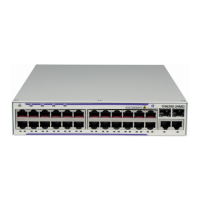MPLS and RSVP
7210 SAS M, T, X, R6, Mxp MPLS Configuration Guide Page 45
This is supported edge-to-edge on an LSP, between two LERs, where normal traffic is transported
either on the working LSP or on the protection LSP using a logical selector bridge at the source of
the protected LSP.
At the sink LER of the protected LSP, the LSP that carries the normal traffic is selected, and that
LSP becomes the working LSP. A protection switching coordination (PSC) protocol coordinates
between the source and sink bridge, which LSP will be used, as working path and protection path.
The PSC protocol is always carried on a G-ACh on the protection LSP.
The 7210 SAS supports single-phased coordination between the LSP endpoints, in which the
initiating LER performs the protection switch over to the alternate path and informs the far-end
LER of the switch.
Bidirectional protection switching is achieved by the PSC protocol coordinating between the two
end points to determine which of the two possible paths (that is, the working or protect path),
transmits user traffic at any given time.
It is possible to configure non-revertive or revertive behavior. For non-revertive, the LSP will not
switch back to the working path when the PSC switch over requests end, while for revertive
configurations, the LSP always returns back to the working path when the switch over requests
end.
The following figures illustrate the behavior of linear protection in more detail.
Figure 16: Normal Operation

